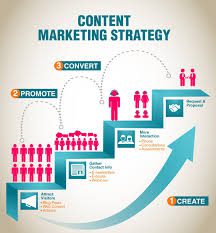Here’s a 900-word article on Content Marketing:

Unlocking the Power of Content Marketing: Strategies, Benefits, and Trends
In today’s digital-first world, content marketing has emerged as one of the most powerful and effective strategies for building a brand, engaging audiences, and driving conversions. From blog posts and videos to podcasts and infographics, content marketing helps businesses attract, inform, and retain customers by delivering valuable, relevant, and consistent content.
In this article, we’ll explore what content marketing is, its key benefits, effective strategies, and current trends shaping the future of this dynamic marketing discipline.
What is Content Marketing?
Content marketing is a strategic marketing approach focused on creating and distributing valuable, relevant, and consistent content to attract and retain a clearly defined audience — and ultimately, to drive profitable customer action.
Unlike traditional advertising, which pushes a product or service directly, content marketing provides useful information that educates, entertains, or inspires the audience. When done right, it builds trust, increases brand awareness, and drives long-term business growth.
Key Benefits of Content Marketing
1. Builds Brand Awareness
Content marketing allows businesses to showcase their expertise and authority in their industry. Publishing quality content on a blog, social media, or YouTube increases visibility and helps your brand become a trusted name.
2. Drives Organic Traffic
By creating search-engine-optimized content, companies can rank higher in search engine results pages (SERPs). This drives continuous, organic traffic without relying heavily on paid ads.
3. Generates Leads and Conversions
Informative content like eBooks, webinars, and how-to guides can turn readers into leads. Calls-to-action (CTAs) placed within content encourage users to sign up, download, or purchase.
4. Builds Trust and Credibility
Sharing helpful, non-promotional content helps you establish a relationship with your audience. When people trust your brand, they’re more likely to buy from you.
5. Supports Other Digital Marketing Efforts
Content fuels SEO, social media marketing, email campaigns, and more. Good content can be repurposed across platforms for maximum impact.
Types of Content Used in Marketing
– Blog Posts: Long-form content for SEO and education
– Videos: Highly engaging and shareable
– Infographics: Visual content that summarizes complex data
– Podcasts: Great for on-the-go audiences
– E-books & Whitepapers: In-depth content for lead generation
– Social Media Posts: Short, interactive content to build engagement
– Email Newsletters: Personalized updates and promotions

Steps to Create a Successful Content Marketing Strategy
1. Define Your Goals
Decide what you want to achieve: brand awareness, leads, sales, customer retention, etc.
2. Know Your Audience
Create detailed buyer personas to understand their pain points, interests, and preferences.
3. Conduct Keyword Research
Use tools like Google Keyword Planner, SEMrush, or Ubersuggest to find keywords that your audience is searching for.
4. Create High-Quality Content
Focus on quality over quantity. Make sure your content is original, well-written, informative, and aligned with your audience’s interests.
5. Choose the Right Channels
Distribute content where your audience is most active — blogs, YouTube, LinkedIn, Instagram, etc.
6. Promote Your Content
Use SEO, email marketing, and social media promotion to boost visibility. Don’t rely on organic reach alone.
7. Measure and Analyze
Track key metrics like page views, bounce rate, time on site, and conversion rate. Use tools like Google Analytics and HubSpot to measure success and tweak your strategy.
Top Trends in Content Marketing (2025)
✅ AI-Generated Content
AI tools like ChatGPT and Jasper are helping marketers create drafts and optimize content faster, though human editing is still crucial.
✅ Interactive Content
Quizzes, polls, calculators, and interactive videos are being used to increase user engagement and time on page.
✅ Voice Search Optimization
With the rise of smart speakers, optimizing content for voice queries (natural language) is essential.
✅ Short-Form Video
Reels, TikToks, and YouTube Shorts are dominating due to their high engagement rates and shareability.
✅ Personalized Content
Delivering personalized experiences using user data (location, preferences, history) increases conversion rates significantly.
Challenges in Content Marketing
Despite its advantages, content marketing does come with its set of challenges:
- Content Saturation: With millions of blogs and videos uploaded daily, standing out is harder than ever.
- Consistency: Producing high-quality content regularly requires time, budget, and skilled resources.
- Measuring ROI: Unlike direct ads, the ROI of content marketing can be hard to quantify immediately.
- Changing Algorithms: Search and social platforms update algorithms frequently, affecting content reach.
Examples of Great Content Marketing
📌 Coca-Cola’s “Share a Coke” Campaign
Personalized bottles and engaging storytelling made this a viral hit.
📌 HubSpot’s Blog and Academy
HubSpot attracts millions through helpful blog posts, free courses, and eBooks.
📌 Nike’s Social Media Stories
Nike focuses on storytelling with emotional and inspirational content that aligns with its brand values.
Conclusion
Content marketing is more than just blogging or posting on social media — it’s about creating meaningful connections with your audience. As customer behavior continues to evolve, so must your content strategy. By staying consistent, audience-focused, and data-driven, businesses can leverage content marketing to build stronger brands, generate leads, and drive long-term success.
Focus Keywords:
- Content Marketing
- Digital Strategy
- Content Creation
- SEO Content
- Content Marketing Trends
If you’d like this in a PDF format or want help creating a visual presentation based on this article, just let me know!
people also read ushttps://mydigiviz.com/